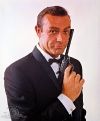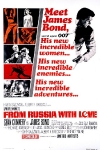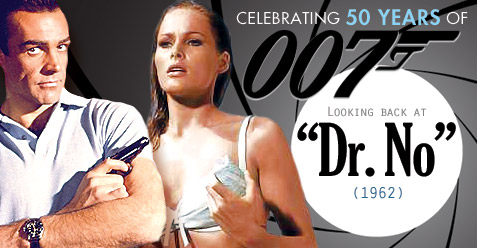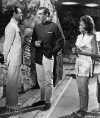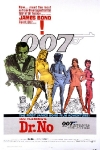007 One by One – From Russia with Love
We continue our look at the film adventures of the world’s most beloved killer spy with the James Bond flick many critics and fans consider the best in the series, based on Ian Fleming’s most acclaimed spy novel.
“From Russia with Love” (1963)
The Plot
After the death of their operative, Dr. No, SPECTRE is one rather peeved diabolical organization bent on world domination. Also, they could use some cash. The villains’ collective therefore devises a plan to steal a hugely prized Lektor decoding device from the Soviets by using the superspy responsible for No’s demise as a pawn. Endgame: Sell the device for a huge sum and kill James Bond. The bait will be the defection, with the Lektor, of a beautiful and unknowing Soviet operative working out of the Russian embassy in Turkey. She is another pawn, a loyal low-level agent who is tricked into cooperating and told to develop a romantic fixation on Bond. The proposal is such an obvious trap, and the Lektor such a desirable prize, that there’s no way the British secret service can possibly resist going to Istanbul for a look. It all wraps up in a sexy and violent trip on the legendary Orient Express and an exciting and dangerous (for stunt men) boat chase.
The Backstory
Following up on the success of “Dr. No,” the EON production team of Albert R. “Cubby” Broccoli and Harry Saltzman elected to follow the lead of the series’ most famous fan. President John F. Kennedy had singled out Ian Fleming’s novel, From Russia with Love, as one of his ten favorite books in an issue of Time Magazine. Despite nearly 100 opening pages in which Bond does not appear, the story was more or less tailor made for a movie, and the rest was a matter of bringing back “Dr. No” writers Richard Maibum and Johanna Harwood to make the story more Hollywood friendly.
First of all, the relatively simple Stalin-era plot of the original novel was updated and complicated to avoid controversy. In light of the more morally complex Khrushchev era and the recent Cuban missile crisis, many viewers were likely to disagree with Ian Fleming’s extremely hawkish, if somewhat tongue-in-cheek, take on the Cold War. And, so a story about ultra-evil Russians trying to take out the West’s most effective counterspy with maximum collateral PR damage, became a tale involving SPECTRE’s desire to grow its cash and power reserves while manipulating MI6 and the KGB into a costly and unnecessary battle. Seeing as the production code was growing weaker even as the Bond budget was growing larger, the sex and violent action quotients was also bumped up considerably from the novel.
Along with newborn superstar leading man Sean Connery, dashing director Terrence Young returned for his second Bond outing after the success of “Dr. No.” Aside from allowing the talented Young to firmly set the tone for the series, bringing him back proved to be a wise choice. Often described him as something of a real-life James Bond, Young was the kind of steady hand the difficult shoot would require.
The challenges Young would face included several changes in locations, numerous reshoots, plus lots of difficult and dangerous stunt work. A scene involving hundreds of rats proved especially tricky because English law permitted only the use of white rats. When the animal wranglers placed cocoa powder on the rats to give them a less hygienic look, the rats were distracted, licking the tasty cocoa powder off themselves and each other. The scene wound-up being shot in Spain.
Murphy’s law was certainly in force on the second Bond film, but director Young took events in stride. He was reportedly back at work within hours after being involved in an apparently minor helicopter crash, though we’re not sure how a helicopter crash can be anything less than a big deal. More tragically, Young also had to deal with the news that key actor Pedro Armendáriz was terminally ill. (More about that below.)
The Bond Girls (Rule of 3 or, in this case, 4)
Yes, an apparent threesome boosts Mr. Bond usual number of consummated movie affairs. The “From Russia with Love” Bond girls are…
Sylvia Trench (Eunice Gayson) — Bond’s Chemin de Fer opponent from “Dr. No” returns. Trench was supposed to be an ongoing liaison in each of the films, but her lakeside tryst with Bond was to be her final appearance. We’re guessing that even a hint of sexual repetition was seen as too much of a hindrance to 007’s womanizing ways. Ironically, Gayson had originally tried out for the longer-lasting but more chaste role of Moneypenny.
Vida and Zora (Aliza Gur and Martine Beswick) — Bond watches with interest, and some concern, as a pair of extremely jealous Gypsy girls stage a to-the-death fight over a man until they are interrupted by a group of Russian-paid Bulgars gunmen. After Bond helps save the day for the Romany, it is strongly hinted that the hot blooded trio spend the rest of the evening making love, not war. (In the novel, Bond is more of a passive observer of some kinky bloodshed.)
As for the talented and lovely ladies who played Vida and Zora, Aliza Gur was a former Miss Israel and Miss Universe semi-finalist. She would later appear in such spy-themed TV shows as “The Man from U.N.C.L.E.” and “Get Smart.” The Anglo-Jamaican Martine Beswick, who may or may not have been one of the dancing silhouettes from the “Dr. No” credits, would return to Bondage as Paula Caplan in “Thunderball” and enjoy a lengthy career as a busy working actress. A supporting role in 1966’s “One Million B.C.” would be followed by such low-budget productions as 1967’s “Prehistoric Women,” 1971’s “Dr. Jekyll and Sister Hyde,” and 1980’s “The Happy Hooker Goes Hollywood.” More upscale roles from the eighties and nineties included “Melvin and Howard,” “Miami Blues,” and the 1993 version of “Wide Sargasso Sea.”
Tatiana Romanova (Daniela Bianchi) — An idealistic operative who thinks she’s working for the Soviets in an operation designed to pass false information to MI6, Tatiana finds it easy to play the role of a love struck defector when she meets the dashing James Bond. Though her loyalties may be divided, her attraction to Bond is undeniable.
Since her character was described as resembling 1930s film star Greta Garbo in the novel, it was a sure bet that former Miss Rome and Miss Universe semi-finalist Bianchi would be lovely and charismatic, if not quite up to the acting standards of the great Garbo. Ms. Bianchi does, however, deliver a credible and very sexy performance, though her Italian accent was removed with a total voice assist from veteran English actress Barbara Jefford. Unfortunately, her best remembered non-“From Russia with Love” outing remains the notorious Eurospy spoof, “Operation Kid Brother,” which starred real-life Sean Connery kid brother, Neil. (Check out this slideshow for more pics of Daniela Bianchi)
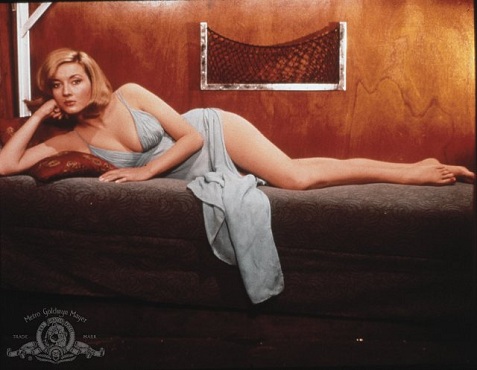
Friends and Colleagues
M (Bernard Lee) and Moneypenny (Louise Maxwell) are both back for more banter. By this point, the pattern is being set for the characters’ fun but exposition-heavy scenes that would be a mainstay of the series for decades to come. The scenes are always somewhat the same: It’s Moneypenny’s job to provide some flirtatious silliness and M’s job to make sure the frivolity doesn’t eat up too much screen time. The business with Bond throwing his seemingly unworn bowler hat on the hat stand makes a return as well. However, “From Russia with Love” gives us two additions to Bond’s onscreen colleagues, each in their own way legendary.
You can follow us on Twitter and Facebook for content updates. Also, sign up for our email list for weekly updates and check us out on Google+ as well.
Posted in: Entertainment, Movies
Tags: 007, 007 50th anniversary, 007 films, 007 gadgets, 007 movies, 007 One by One, 007 one-liners, 007 villains, Albert R. "Cubby" Broccoli, Ali Kerim Bey, Aliza Gur, Anthony Dawson, beautiful Bond women, Bernard Lee, best Bond movie moments, Bond babes, Bond films, Bond gadgets, Bond girls, Bond movies, Bond one by one, Bond villains, Daniela Bianchi, Desmond Llewellyn, Donald "Red" Grant, Ernst Stavro Blofeld, Eunice Gayson, From Russia With Love, From Russia with Love movie, Harry Saltzman, iconic James Bond moments, Istanbul, James Bond, James Bond 007, James Bond 50th anniversary, James Bond actresses, James Bond babes, James Bond blog, James Bond cars, James Bond craze, James Bond drinks, James Bond franchise, James Bond girls, James Bond hookups, James Bond movies, James Bond music, James Bond one-liners, James Bond romantic endings, James Bond villains, James Bond violence, John F. Kennedy, Kronsteen, license to kill, Lotte Lenya, Louise Maxwell, Major Boothroyd, Martine Beswick, Maurice Binder, memorable Bond scenes, Moneypenny, movie one-liners, Pedro Armendáriz, Robert Brownjohn, Robert Shaw, Rosa Klebb, SPECTRE, Sylvia Trench, Tatiana Romanova, Turkey, Vida and Zora, Vladek Sheybal





